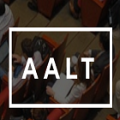Figures in scientific publications contain important information and results, and alt text is needed for blind and low vision readers to engage with their content. We conduct a study to characterize the semantic content of alt text in HCI publications based on a framework introduced by Lundgard and Satyanarayan. Our study focuses on alt text for graphs, charts, and plots extracted from HCI and accessibility publications; we focus on these communities due to the lack of alt text in papers published outside of these disciplines. We find that the capacity of author-written alt text to fulfill blind and low vision user needs is mixed; for example, only 50% of alt texts in our sample contain information about extrema or outliers, and only 31% contain information about major trends or comparisons conveyed by the graph. We release our collected dataset of author-written alt text, and outline possible ways that it can be used to develop tools and models to assist future authors in writing better alt text. Based on our findings, we also discuss recommendations that can be acted upon by publishers and authors to encourage inclusion of more types of semantic content in alt text.
翻译:科学出版物中的数字含有重要的信息和结果,盲人和低视力阅读者需要读取替代文本,以了解其内容。我们根据Lundgard和Satyanarayan提出的一个框架,进行了一项研究,以说明HCI出版物中的alt文本的语义内容。我们的研究侧重于图表、图表和从HCI和无障碍出版物中提取的图纸的替代文本;我们注重这些社区,因为这些学科之外发表的论文中缺乏替代文本。我们发现,作者撰写的alt文本满足盲目和低视力用户需求的能力好坏参半;例如,我们样本中的替代文本中只有50%含有关于extrema或外围线的信息,只有31%包含关于该图传递的主要趋势或比较的信息。我们公布了我们收集的关于作者撰写替代文本的数据集,并概述了可以用来开发工具和模型以帮助未来作者编写更好的alt文本的可能方法。根据我们的调查结果,我们还讨论出版商和作者可以采取行动的建议,以鼓励将更多种类的语义内容纳入alt文本。




